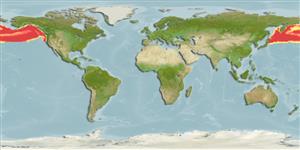>
Lophiiformes (Anglerfishes) >
Oneirodidae (Dreamers)
Etymology: Oneirodes: Greek, 'oneiros' = a dream or dreamlike or out of a dream (suggesting this fish is so strange and marvelous that can exist only in dreams) (Ref. 86949).
Environment: milieu / climate zone / depth range / distribution range
Ecologia
marinhas batipelágico; intervalo de profundidade 200 - 2000 m (Ref. 50550), usually 600 - 850 m (Ref. 86949). Deep-water; 66°N - 30°N, 142°E - 117°W
North Pacific: Okhotsk and Bering seas and off British Columbia, Canada (Ref. 11980).
Tamanho / Peso / Idade
Maturity: Lm ? range ? - ? cm
Max length : 23.0 cm TL macho/indeterminado; (Ref. 56582); common length : 14.8 cm TL macho/indeterminado; (Ref. 56582); peso máx. publicado: 450.00 g (Ref. 56582)
Descrição suscinta
Chaves de identificação | Morfologia | Morfometria
Espinhos dorsais (total) : 0; Raios dorsais (total) : 6 - 7; Espinhos anais: 0; Raios anais : 4; Vértebras: 19. Escal bulb bearing an anterior appendage with numerous long filaments at its distal end, a pair of medial appendages with highly branched filaments, a short round papilla and posterior appendages with 2 short filaments (Ref. 559).
Characterized by having similar characteristics like that of O.eschrichtii and O.anisacanthus; posterior margin of the upper part of subopercle is indented to deeply notched; length of ventral fork of opercle 28.6-35% SL; ratio of lengths of dorsal and ventral forks of opercle 0.55-0.60; absence of epibranchial teeth; presence of teeth on pharyngobranchial II; upper jaw teeth 23-39; lower jaw teeth 24-40; teeth on vomer 4-8; dorsal fin rays 6-7; anal fin rays 4; pectoral fin rays 15-18; head length 37.6-49.1% SL; head depth 39.1-50.8% SL; length of premaxilla 29.1-38.6% SL; lower jaw length 44.1-56.1% SL; illicial length 23.1-38.6% SL (Ref. 86949).
Ciclo de vida ou comportamento de acasalamento
Maturities | Reprodução | Spawnings | Egg(s) | Fecundities | Larvas
Masuda, H., K. Amaoka, C. Araga, T. Uyeno and T. Yoshino, 1984. The fishes of the Japanese Archipelago. Vol. 1. Tokai University Press, Tokyo, Japan. 437 p. (text). (Ref. 559)
Status na Lista Vermelha da UICN (Ref. 130435)
Ameaça para os humanos
Harmless
Uso pelos humanos
Ferramentas
Relatórios especiais
Baixar XML
Fontes da internet
Estimates based on models
Preferred temperature (Ref.
123201): 1.6 - 3.7, mean 2.3 °C (based on 51 cells).
Índice de diversidade filogenética (Ref.
82804): PD
50 = 0.5000 [Uniqueness, from 0.5 = low to 2.0 = high].
Bayesian length-weight: a=0.01995 (0.00906 - 0.04395), b=3.01 (2.83 - 3.19), in cm total length, based on all LWR estimates for this body shape (Ref.
93245).
Nível Trófico (Ref.
69278): 4.5 ±0.80 se; based on food items.
Resiliência (Ref.
120179): médio(a), tempo mínimo de duplicação da população 1,4 - 4,4 anos (Preliminary K or Fecundity.).
Fishing Vulnerability (Ref.
59153): Low vulnerability (13 of 100).
